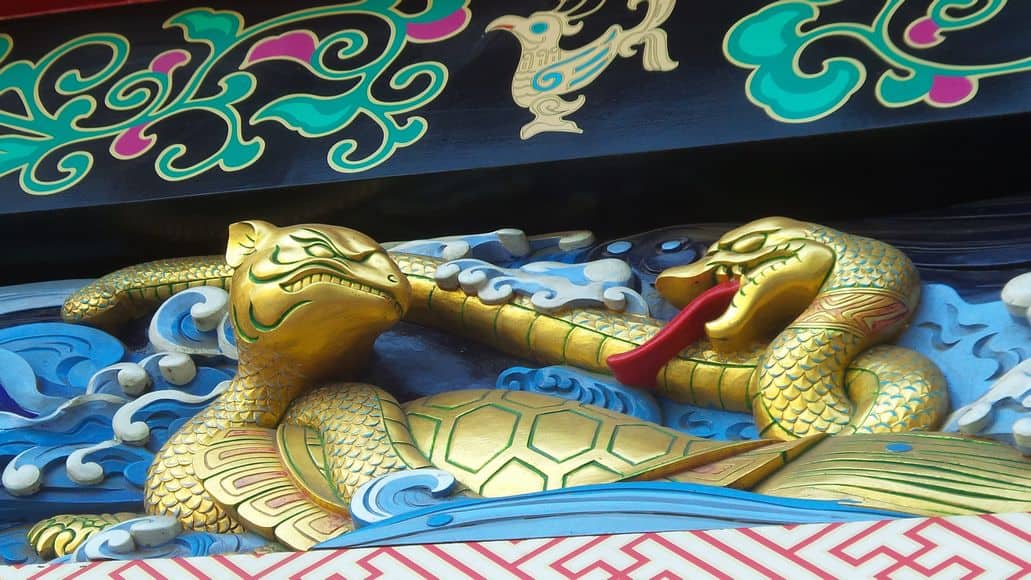
You never hear about snakes in Japan either.
If asked, most people probably see Japan as an island without native snakes, similar to Hawaii.
But the truth is very different.
In fact, despite living there for 3 years, I was surprised by what I learned.
I bet you will be too.
Table of Contents
Are There Snakes In Japan?
Yes, there are snakes (hebi in Japanese) in Japan. More than 40 species of snakes are native to Japan. The majority of Japan’s snake population are non-venomous.
As is the case in many countries, the snake is deeply rooted in Japanese folklore.
Snakes In Japanese History

The ancient Chronicles of Japan detail the legend of Yamata no Orochi, a terrible eight-headed serpent who ate royal children. A clever warrior slays the giant snake and saves the princess Kushiinada from being sacrificed.
Similar to western traditions of snakes, the snake in Japanese mythos often carries negative connotations. Thankfully, there have been no sightings of giant and terrible eight-headed snakes in modern Japan.
Poisonous Snakes Of Japan
The majority of snakes native to Japan’s islands are harmless. But a handful of venomous snakes and sea snakes across Japan’s major islands are known for having extremely potent venom.
Whether you’re interested in traveling the Japanese countryside, planning on heading to Okinawa’s beaches, or simply curious, it helps to know which Japanese snakes are venomous.
Here are three of the most interesting and lethal snakes native to Japan.
The Japanese Mamushi

The Japanese Mamushi, or Gloydius blomhoffii, belongs to the venomous pit viper species. This species of snake can be found in Japan, and less commonly in parts of China and Korea.
The official classification (Gloydius blomhoffii) honors Jan C. Blomhoff, director of the Dutch trading colony who discovered the snake while staying in Nagasaki from 1817 to 1824.
The Japanese Mamushi is Japan’s most common and most dangerous snake. It is hardy and is distributed across most of the habitats present in Japan’s major islands: woods, meadows, swamps, marshes, hills, and mountainous regions. It lives on Japan’s minor islands as well.
The good news is the snake is quite shy.
The pit viper’s diet consists mainly of frogs, mice, and small birds—though it is also known to eat other lizards and insects.
The Japanese Mamushi hunts its prey by using its powerful venom. Mamushi venom liquefies the tissues of its victims. If left untreated, it can lead to a myriad of complications.
What makes the Japanese Mamushi particularly dangerous to humans is that it hunts in the day and night. Combined with its adaptive camouflage, it can be tricky to spot before it’s too late.
In Japan, the mamushi bites an estimated 2,000 to 3,000 people every year. Thanks to treatment protocols in Japanese hospitals, Mamushi bites are mostly non-fatal.
Signs warning of Japanese Mamushi nests and sightings are all over the country. Keeping a cautious eye out for this snake and wearing high socks and jeans when hiking is usually enough to avoid trouble.
The Habu

Native to Okinawa and the Amami Islands, the Habu is another venomous pit viper native to Japan. Also known as Protobothrops flavoviridis, it is the longest and most venomous of the three habu species found in the Ryukyu Islands.
Contrasted with the Mamushi’s brown diamond patterns, the Habu wears a lighter shade with dark green blotches and olive hues. Located in trees, palm fields, and rock walls, the habu is a nocturnal hunter.
Though rarer to find, there are high numbers of bites reported by natives of the Amami Islands. The venom of the habu is rarely life-threatening with medical intervention.
Where people are most likely to find a habu is in the bottom of an Okinawan liquor bottle. Habu snakes are often coiled up and preserved at the bottom of a bottle of Okinawan awamori.
The habu is a staple of the Okinawan habu sake. This special rice liquor harkens back to the days when Okinawa was the Ryukyu Kingdom, independent from Japan. Today, tourists can still buy and purchase habu sake (with or without the snake in the bottle).
The Chinese believed the habu had medicinal properties, and in their trade and interactions with modern-day Okinawa, the snake became a special ingredient for the rice liquor.
The Yamakagashi

Also known as the Japanese Grass Snake, or the Tiger Keelpack, this is an intriguing and rare snake native to Japan.
The snake’s title of Tiger Keelback has to do with the magnificent patterns and colors of its scales.
The snake’s head is typically a mix of olive and green, but the rest of the body has a pattern of black spots and brilliant orange hues leading to the tail. The belly of the snake is a bright yellow.
The Yamakagashi, designated Rhabdophis tigrinus, is common across Japan. They can live in mountains, near water, or in rice paddy fields. Their active months span from April to November, and they brumate the rest of the year.
What makes the Japanese Keelpack so compelling?
The yamakagashi belongs to the Colubridae family, a massive family of (mainly) harmless snakes like the garter snake.
The majority of colubrid snakes are non-venomous.
The yamakagashi is an exception, and does have the ability to inject venom, which is stored in specialized glands in the neck.
The yamakagashi does not have grooved teeth in the front like most venomous snakes. Instead, it can inject victims or predators by using maxillary fangs located far back in the upper jaw (think biting with your molars).
The venom is released from the above mentioned neck glands when the snake engages its rear fangs. The Japanese keelback can also discharge venom in the form of yellow fluid. It can spray this if it is picked up or pressure is applied to the neck glands.
It gets even crazier—the yamakagashi does not produce its own venom. Instead, it collects it by feeding on venomous toads.
This means an individual snake will only have venom in its glands if it has been feeding on venomous toads.
The Japanese tiger keelback has evolved to sequester the venom for use in its own defense. Female yamakagashi (with high levels of this venom) can provide their offspring with some venom of their own to get them started off on the right foot in life.
Getting bit by a yamakagashi is a rare phenomenon. Since 1917, only 29 reports of yamakagashi bites have been reported. The venom is typically non-lethal, and there is always a good chance no venom will be used anyway, due to the snake’s physiology.
Since Japanese tiger keelback snakes have fangs far in the back of their mouth, instead of the front like pit vipers, they don’t generally bite with the intent to envenom.
Most humans who are exposed to the venom are not exposed via a bite, but because they try to catch the snake and squeeze its poison glands. It is mostly dangerous if it gets in your eyes.
Antivenom does exist, and is present in most hospitals.
Honorable Mentions
Some of the other venomous snakes in Japan include the Tsushima Mamushi, Himehabu, Sakishima Habu, and Tokarahabu.
Snakes In Japan: Final Thoughts
Japan is not a place with no snakes. It is actually home to many species of snakes, including some extremely venomous ones.
But even the venomous snakes don’t pose much danger to humans, because they are shy and do their best to avoid us.
Some people worry about encountering snakes in Japan’s hot spring. That is not something you need to worry about. Japan is hot in the summer, so snakes don’t need the hot water to keep their temperatures up.
And in the winter, they are brumating and don’t generally come out to warm up in a hot spring. There is no snake in Japan like the Tibetan Hot Spring snake.

Leave a Reply